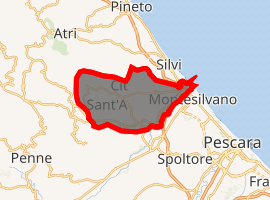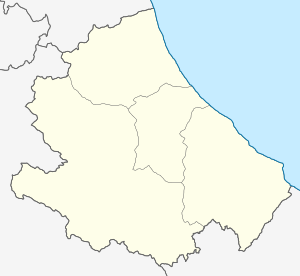Città Sant'Angelo
Città Sant'Angelo (Italian: [tʃitˈta sanˈtandʒelo]) is a city and comune in the province of Pescara, Abruzzo, Italy.
Città Sant'Angelo | |
|---|---|
| Comune di Città Sant'Angelo | |
 | |
 Coat of arms | |
Location of Città Sant'Angelo 
| |
 Città Sant'Angelo Location of Città Sant'Angelo in Italy  Città Sant'Angelo Città Sant'Angelo (Abruzzo) | |
| Coordinates: 42°31′N 14°03′E | |
| Country | Italy |
| Region | Abruzzo |
| Province | Pescara (PE) |
| Frazioni | Alzano, Annunziata, Crocifisso, Fagnano, Fonte Umano, Gaglierani, Maddalena, Madonna della Pace, Marina, Piano della Cona, Piano di Sacco, Ponticelli, San Giacomo, San Martino, San Pietro, San Rocco, San Vittorino, Sant'Agnese, Sorricchio, Vertonica, Villa Cipressi |
| Government | |
| • Mayor | Matteo Perazzetti (Brothers of Italy) |
| Area | |
| • Total | 61 km2 (24 sq mi) |
| Elevation | 322 m (1,056 ft) |
| Population (30 September 2016)[2] | |
| • Total | 15,056 |
| • Density | 250/km2 (640/sq mi) |
| Demonym(s) | Angolani |
| Time zone | UTC+1 (CET) |
| • Summer (DST) | UTC+2 (CEST) |
| Postal code | 65013 |
| Dialing code | 085 |
| Patron saint | Saint Michael the Archangel |
| Website | Official website |
History
The origins of Città Sant'Angelo are uncertain and have always been a basis for historical discussion, beginning with the Vestini. The numerous archaeological finds between the mouths of Piomba and Saline Rivers, and the presence of small urban aggregates at the site called Marina Sant'Angelo point to the origins of the city during the Roman period, located in the eastern portion of the Vestine region.[3] Città Sant'Angelo appears to be located where Plinius wrote of the existence of the one of the four Vestini cities, either Angelus or Angulum.[4] It is cited from the 12th century as Castrum Sancti Angeli (Latin: "Castle of the Holy Angel").

However around 400 CE, the first churches took root in the area between Città Sant'Angelo and Atri. The vestino-roman abodes, which would have been located in the nearby Salt Hill, were probably destroyed in the early Middle Ages, probably during the Gothic War (535–554); the Longobards (Lombards) who invaded Italy after the Gothic War, would likely have rebuilt the areas from scratch in their present location, leaving as the trace of their later presence the worship of the Michael (archangel). Testimonies of this cult are present in both the local landmark and the municipal coat of arms.
The first official record found where the municipality mentions a concession from the Emperor Ludovico II (Louis II of Italy) who granted a privilege to the Monastery of Casauria on the site called "CIVITATE S. ANGELI" where there was a castle and a port and dated 13 October 875.[3]
In the 12th century it was aggregated to Loreto County by the Normans who established the Kingdom of Sicily. It was a Guelph city destroyed in 1240 by Boemondo Pissono, executioner to Frederick II, Holy Roman Emperor of the Hohenstaufen dynasty, and successor to the Normans as the King of Sicily, because the city was too loyal to his enemy, the Roman Catholic Church.[5] The city was rebuilt quickly and took the shape of a fortified nucleus in a semicircle. The most prominent names were those of Zizza and Salomone. The arrival of the monastic orders in the first half of the 14th century generated widening interest and finally a monastery was established. By 1528 it obtained the current name of the city. In this era, Città Sant'Angelo was one of the three major cities of the Penne-Atri diocese, along with the two bishopric sites. This rivalry often resulted in wars, especially for port control, at the border between the current Silvi Marina and Pineto, in the province of Teramo. In the 16th century it was aligned to the Castriota family together with the lands of Spoltore, Moscufo and Montesilvano. It gradually became one of several feudal possession, between the Carafa and the Piccolomini of Celano, who then gave it to the Pinelli.
Gradually an agrarian bourgeoisie firmly established itself through to the 17th century. On 18 February 1699 Lucrezia Camerlengo bought on behalf of her son Francesco Figliola the Angolan marquis from Pinelli for 130,000 ducats. Francesco Figliola transformed the marquisate into a duchy.
Between 1300 and 1700, Città Sant'Angelo, despite numerous attacks by French and Spanish, met a period of splendor. In the Treaty of Aix-la-Chapelle (1748) the city passed definitively to the Kingdom of Naples. Italy gained stability for the first time in the 18th century. The new territorial settlement and the accession of the peaceful Ferdinand VI of Spain allowed the peace settlement to last until the outbreak of the French Revolutionary Wars in 1792.
In March 1814, Città Sant'Angelo together with the municipalities of Penne, Castiglione Messer Raimondo and Penna Sant'Andrea were the protagonists of the first ups and downs of Carboneria of the Italian Risorgimento. The revolt was repressed by the troops of Gioacchino Murat, led by General Florestano Pepe, thanks to the betrayal of a conspiracy and the non-adherence of several municipalities that after giving their positive opinion remained silent. Angolan chiefs of the uprising, Philip La Noce and Domenico Marulli were shot at Penne and their heads were displayed on Porta Sant'Angelo, the main gate, while Michelangelo Castagna, another head of the revolt, managed to escape finding shelter with his sister in the town of Atri.
Prior to joining the Kingdom of Italy, Città Sant'Angelo was the capital city from 1837 to 1848 in the Distretto di Città Sant'Angelo, an administrative unit of Abruzzo Ulteriore Primo (the future Province of Teramo), a province of the Kingdom of the Two Sicilies, then returned to Penne County when the capital was returned to Penne.
At the turn of the 20th century, many people left the region and joined the mass migration to the Americas.
During the Second World War in April 1940 the Ministry of the Interior set up and rented the building of the Ex Manifattura Tabacchi, in the historic center of the city, to serve it as the only concentration camp of the province of Pescara with about 200 prisoners from Yugoslavia. The location remained active until April 1944. Currently, it is permanently hosted by the Museum of Contemporary Art. On May 22, 1944, the US Air Force bombed the marina district; seventeen Angolan lives lost, in addition to German soldiers. On Monday, June 12, 1944 Città Sant'Angelo was liberated by the Allies.
Today, it is known for its historical architecture and as a tourist location that offers its own variety of wine and cuisine.
Points of interest
Città Sant'Angelo is a member of the club "I Borghi più belli d'Italia". Among its dominant landmarks is undoubtedly the Church of St. Michael, while the entire center is characterized by 18th-century brick houses. The following are distinctive points of interest:[6]
- The parish church of San Michele Arcangelo (Collegiate Church) of the 13th century, with beautiful stone portal of 1326, an interesting Nativity fresco in the attic, a 14th-century bell tower, and inside the choir wooden Baroque frescoes of the first half of the 15th century. It has a 48-metre-tall (157 ft) bell tower and houses remains of an early medieval pulpit from the 7th-8th centuries, as well as a portico and the tomb of bishop Amico di Buonamicizia, both from the 15th century.
- The Church of St. Francis, with a fine 14th-century portal of the Atri school; the interior was renovated in 1741
- The Church of St. Augustine, with 18th-century stuccos by Terzani
- The Church of St. Bernard formerly church of the Cistercian Riformati, whose monastery was erected later next to the church. Now Baroque, it has remnants of the old building on one side.
- The Church of St. Chiara, on a baroque circular plan with three chapels; stucco decorations of Carlo Piazzoli and Girolamo Rizza;
- Park Place Botanical Gardens, near the river
- The Church of San Salvatore, an oratorium
- A number of fine palaces: Palace Astagno, Palace Brandimarte, Palace Ghiotti and Palace Ursini
- Museo Laboratorio d'Arte: housed in the old Manifattura Tabacchi
People
- Massimo Oddo, World Cup-winning footballer.
- Ruggero Pasquarelli, actor in the Disney Channel original series Violetta and Soy Luna.
- Felice Gasperi, footballer, he died in Città Sant'Angelo in 1982.
- Lino Grava, footballer, he died in Città Sant'Angelo in 2010.
- Michelangelo Castagna, (1783 - 1865) one of the leaders of the Italian Carbonari in 1814, whose goal was a constitution for the Kingdom of the Two Sicilies.
Sport
The local football team is the Renato Curi Angolana, that it current plays in Eccellenza Abruzzo. The futsal club is Acqua e Sapone Calcio a 5, that it current plays in Serie A.
See also
Citations
- "Superficie di Comuni Province e Regioni italiane al 9 ottobre 2011". Istat. Retrieved 16 March 2019.
- Popolazione Residente al 1° Gennaio 2018
- Visit Città Sant'Angelo - Città Sant'Angelo nella storia
- Plinius Secundus
- Busk, pp. 8-11.
- Città Sant'Angelo, province of Pescara, Abruzzo, Italy
References
- Busk, M.M. (1836). Mediæval popes, emperors, kings, and crusaders; or, Germany, Italy, and Palestine from A.D. 1125 to A.D. 1268, Volume IV. London: Hookham & Sons. Retrieved 5 March 2020.
- "Città Sant'Angelo, province of Pescara, Abruzzo, Italy". www.italyheritage.com. Retrieved 2017-08-30.
- "Popolazione Residente al 1° Gennaio 2018". Istat. Retrieved 16 March 2019.
- Plinius Secundus, Gaius. Naturalis Historia (Book II 12.106).
- "Superficie di Comuni Province e Regioni italiane al 9 ottobre 2011". Istat. Retrieved 16 March 2019.
- "Visit Città Sant'Angelo - Città Sant'Angelo nella storia". www.visitacsa.it. Archived from the original on 2017-08-29. Retrieved 2017-08-30.
External links
| Wikimedia Commons has media related to Città Sant'Angelo. |